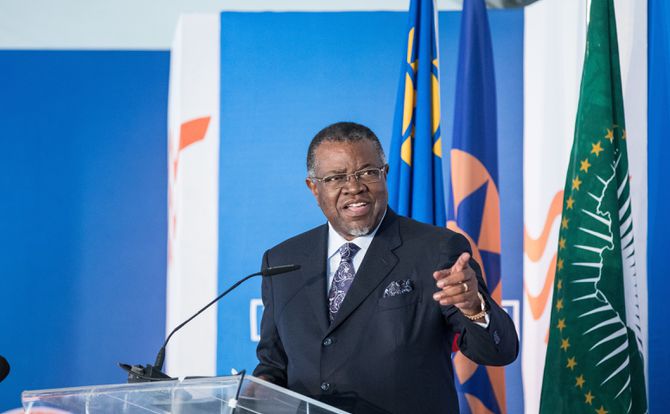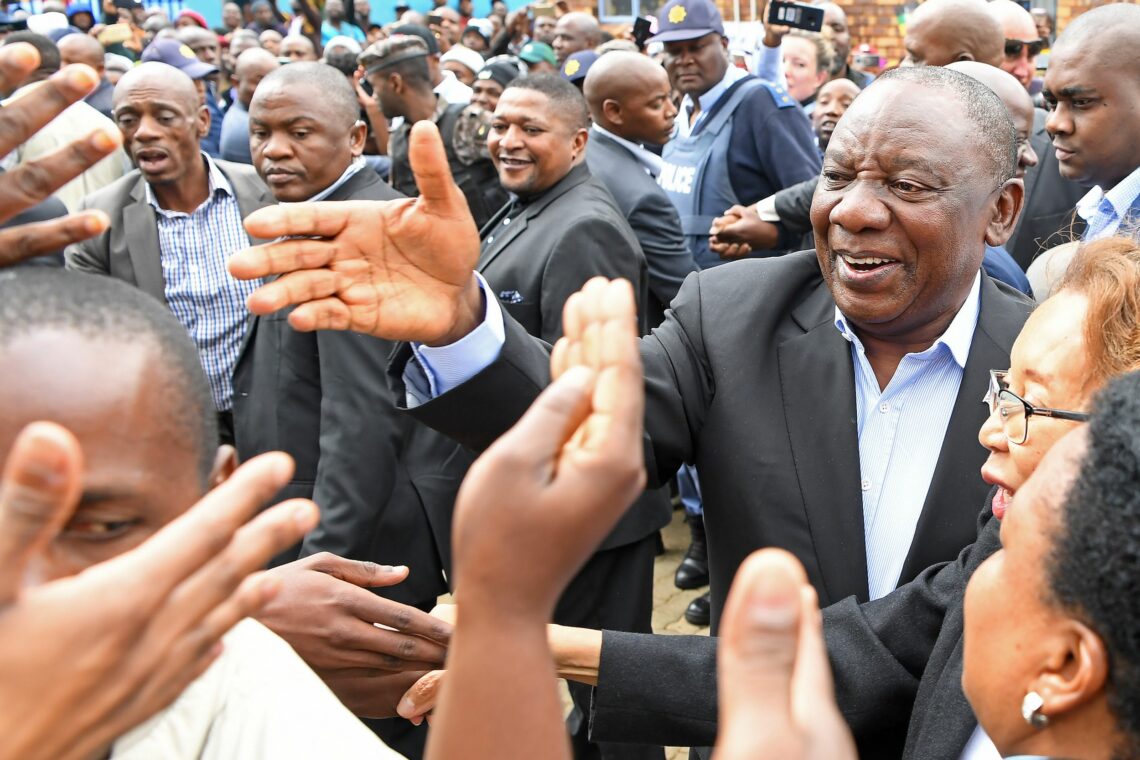Namibia faces political and economic uncertainty
Although Namibia has enjoyed good economic conditions for years, soon, it may face a turning point in the aftermath of the upcoming 2019 elections. Growth has stagnated, and political polarization has weakened the ruling SWAPO party.

In a nutshell
- After years of stability, Namibia faces a crossroads
- The ruling party faces new opposition ahead of elections
- Worsening economic conditions may soon lead to a crisis
Since its independence in 1990, Namibia has been seen as a success story of democratic transition in Africa, one anchored in peace, stability, good governance and respect for fundamental rights. However, a closer analysis suggests that Namibia is a hybrid regime, where democratic principles and practices, such as regular elections and respect for the constitution, coexist with a dominant-party system.
With general elections scheduled for November, Namibia may be reaching a turning point. While the South West African People’s Organization (SWAPO) will likely remain the country’s dominant political force, a combination of factors – including regional developments, demographic trends, economic underperformance, high inequality and the emergence of vocal radical groups – may make the status quo unsustainable in the medium- to long-term.
The Namibian exception
From Zimbabwe to South Africa, Mozambique and Tanzania, ex-liberation movements have struggled to maintain their hegemony after transitioning into political parties. Namibia’s SWAPO party stands as an exception, the former independence group that has strengthened its dominant position in recent years.
In the 2014 parliamentarian elections, SWAPO scored a landslide victory (80 percent), while the party’s presidential candidate, Hage Geingob, was elected by an unprecedented 87 percent of the voters to succeed former president Hifikepunye Pohamba. While the advantages of incumbency were important factors, not least the party’s monopoly over state resources, these victories reflect the fact that liberation credentials are still an important factor of political legitimacy in Namibia.
Political parties are ceding influence to growing social movements, and the opposition is weak and fragmented.
Having served as prime minister between 1990 and 2002 and between 2012 to 2015, Mr. Geingob is an experienced politician and a member of Namibia’s old guard, the generation that negotiated independence and led the transitional process. Coming to power as president in 2015 during a critical moment, with the country facing a deteriorating economic outlook, Mr. Geingob has struggled to maintain a conciliatory tone. However, a combination of regional trends and internal circumstances have forced him to take a stand on difficult issues like land reform and economic empowerment.
November elections
While SWAPO’s hegemony will likely be reaffirmed, the November elections will take place in a context of important structural changes. Polarization on economic and social questions is increasing. Political parties are ceding influence to growing social movements, and the opposition is weak and fragmented. Demographic changes mean that, for the first time in Namibia’s history, the majority of voters were after the country gained independence.
Challenges to the government’s approach to land redistribution have emerged from both within and outside the party system. In 2017, after being dismissed by the president, Namibia’s Deputy Minister of Land Reform Bernardus Swartbooi joined the Landless People’s Movement (LPM), which was approved as a political party in February and will contest the November elections. The main claim of the LPM, which is a rural-oriented movement promising a “radical agricultural revolution” through land redistribution and agrarian reform, is the devolution of land to certain ancestral tribes.
Like Julius Malema in South Africa, dissenters from the SWAPO youth league have also created a movement which defies the party’s hegemony through a radical and mainly urban-based perspective on land redistribution and affordable housing. Denouncing what they characterize as “capitalist anarchy,” the Marxist-inspired Affirmative Reposition movement has been challenging the government’s policies on land since 2014 with both conventional and unconventional means, including legal proceedings and forced occupations.
Economic outlook
While Namibia has also been among Africa’s most stable and successful countries on the economic front, the current situation is particularly challenging. Following five years of expansion (2010-2015) driven by a mining and construction boom, the Namibian economy has entered into a period of deceleration.
In 2016, President Geingob launched the Harambee Prosperity Plan, a multiyear initiative that reflected the government’s efforts to strike a difficult balance between growth and redistribution. The plan was based on an assumption of a 7 percent growth rate and highlighted the need to address critical social inequities without undermining the spirit of entrepreneurship. However, its implementation has been torpedoed by the economic recession of 2017-18, as the country drifted away from the ambitious 7 percent target.

The country’s gross domestic product (GDP) contracted by 0.9 percent in 2017 and 0.1 percent in 2018. While Namibia is not among the African countries at risk of debt distress, its debt-to-GDP ratio increased by 25 percent between 2010 and 2017. The economic outlook has worsened because of anemic growth in South Africa, not least because the Namibian dollar is pegged to the South African rand. Moreover, a severe drought has left 500,000 Namibians (from a total population of 2.6 million) without sufficient access to food, forcing the government to declare a national state of emergency.
2019 has also been marked by decreases in economic activity across important sectors, including agriculture, construction, tourism and wholesale and trade. The ongoing fiscal consolidation efforts – which aim to lower the deficit to 2.7 percent of GDP by 2022 and limit public debt to 48 percent of GDP – are further constraining domestic demand.
Besides a common past of settler colonialism, Namibia also shares a series of socioeconomic challenges with South Africa. The country has been ranked the second most unequal country in the world, surpassed only by South Africa. Like its neighbor to the south, Namibia also struggles with land issues in a context of persisting inequality, urban pressure and high unemployment – estimated at 34 percent overall and 43 percent among those aged 15-34. According to United Nations data, in 2017, 29 percent of the Namibian population was undernourished and 30 percent of children under five suffered from stunted growth.
However, unlike the South African case, developmental policies in Namibia throughout the last two decades have had overall positive, albeit modest, results. Living conditions have been improving: between 1998 and 2017, life expectancy increased from 50.1 in 1998 to 64.9 in 2017; the human development index increased from 0.558 to 0.647, and gross national income per capita improved from $6,160 to $9,387.
Scenarios
Despite its current challenges, SWAPO will likely achieve a comfortable victory in the 2019 elections and Hage Geingob will be reelected. Notwithstanding this short- and medium-term continuity, however, the main economic and political trends that have shaped independent Namibia – a dominant party system and a market economy – may progressively change during the coming years. The determining factor, in this case, will be the extent to which SWAPO can restore growth and mitigate the adverse impact of the current slowdown, while avoiding major cracks in the country’s social structure. In this context, two broad scenarios should be considered.
Slow recovery and stabilization
Under this more likely scenario, SWAPO will be the sole and clear winner of the November general elections and President Hage Geingob will be reelected by a large majority of voters. Achieving a comfortable victory and a five-year mandate, President Geingob will focus on the economic front, being less politically vulnerable to pressures from various factions in SWAPO, opposition parties and social movements.
The resumption of economic growth will depend on several factors, including the evolution of global commodity prices; the regional economic outlook (particularly the situation in South Africa, Namibia’s main trading partner); the performance of the country’s mining sector; the success of Geingob’s reformist efforts, including fiscal consolidation and land reform; and the capacity to attract foreign investment. Economic recovery, however, will be slow, and even under a best-case (and unlikely) scenario combining positive global and regional trends with macroeconomic efforts, the situation is expected to get worse before it gets better.
Considering the current context, Namibia benefits from two main competitive advantages when compared with other countries in the region. First, a solid reputation for being a stable democracy and a market-friendly, functioning economy. Second, being a small economy, Namibia can significantly benefit from increases in foreign investment, which the government is targeting through specific initiatives.
Worsening economic conditions amid social instability
This is a slightly less likely scenario, as one of its main causes would be a significant loss of legitimacy by the ruling party and Hage Geingob after the November elections. This hypothesis seems remote if, despite increasing polarization on fundamental issues like the land question, SWAPO retains a position of clear hegemony.
But land-related protests and illegal occupations have increased in recent months. Land redistribution is particularly challenging in the Namibian case. First, because the government is struggling to strike a delicate (and ultimately unsustainable) balance between market-friendly policies and the expropriation of land, as the party and public increasingly support redistributive measures. Second, because there are different and irreconcilable claims, with many constituencies accusing the government of benefiting certain groups to the detriment of others.
In the (likely) event of a continued economic deceleration in the Southern African Development Community, the slowest growing region in Africa, Namibia’s recovery will largely depend on a combination of internal reforms and foreign investment. Mounting social instability and uncertainty regarding property rights, in this case, could severely compromise the country’s economic outlook. The country could slip into a vicious cycle since, as in South Africa. The deterioration of living standards and a growing perception of inequality among urban and rural constituencies could trigger more popular contestation and political instability.







